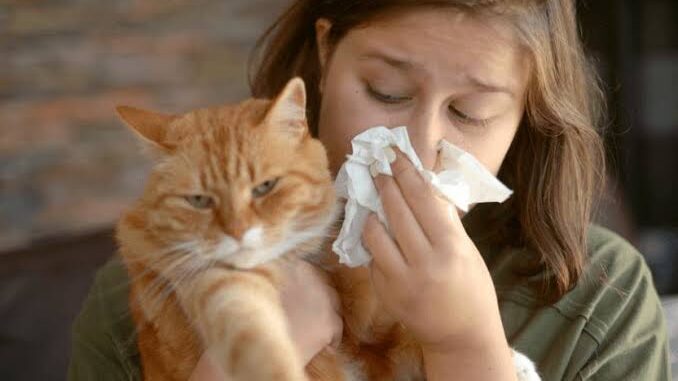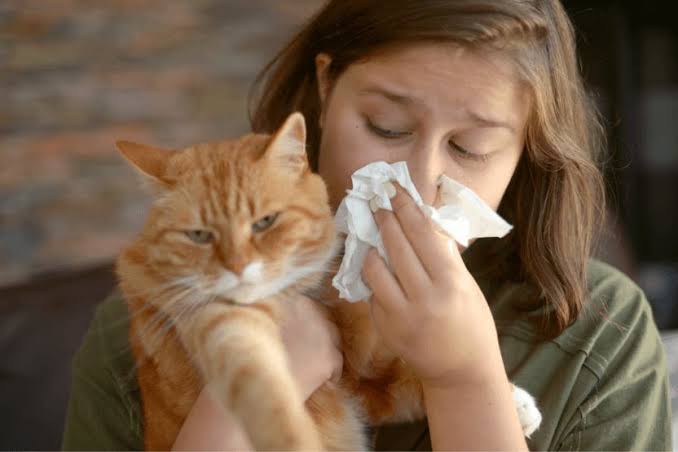
Tips for Managing Cat Allergies in Humans: Many people who adore cats find themselves struggling with the downside of their love cat allergies. Sneezing, itchy eyes, nasal congestion, and even asthma symptoms can make living with or near cats uncomfortable. But the good news is that you don’t necessarily have to choose between your health and your feline companion.

With the right strategies, managing cat allergies is entirely possible. This article walks you through five expert-backed tips for minimizing allergic reactions while continuing to enjoy the company of your cat. We’ll also answer some frequently asked questions to help you better understand what triggers allergies and how to reduce their impact.
Understanding Cat Allergies
Before diving into solutions, it helps to understand the problem. Cat allergies are caused by a protein called Fel d 1, which is found in a cat’s saliva, skin, and dander (tiny flakes of skin). When a cat grooms itself, the allergen-laden saliva dries and becomes airborne, triggering allergic reactions in sensitive individuals.
These proteins can stick to furniture, clothing, and even walls, making them hard to avoid completely. However, with persistence and the right approach, you can significantly reduce your exposure.
Tip 1: Create an Allergen-Free Sanctuary in Your Home
One of the most effective ways to manage cat allergies is by creating a designated allergen-free space, especially your bedroom. You spend several hours a day in your bedroom—keeping it free from allergens can dramatically improve your symptoms.
How to implement:
- Keep your cat out of the bedroom at all times.
- Use HEPA (High-Efficiency Particulate Air) filters in your air purifier and HVAC system.
- Wash bedding weekly in hot water (at least 130°F/54°C) to kill allergens.
- Use dust-mite-proof covers for pillows and mattresses to prevent allergen accumulation.
- Avoid heavy drapes and carpets, which can trap allergens—opt for washable window coverings and hard flooring instead.
Bonus Tip:
Consider adding a HEPA vacuum to your cleaning routine. Models with sealed systems trap even microscopic allergens.
Tip 2: Practice a Diligent Cleaning Routine
Cat allergens are sticky and pervasive—they can remain airborne or cling to surfaces for months. A consistent and thorough cleaning routine is essential for allergy control.
Cleaning must-dos:
- Vacuum frequently (2–3 times a week) using a vacuum with a HEPA filter.
- Dust with damp cloths to trap particles instead of spreading them.
- Mop floors regularly, especially if you have hard flooring.
- Clean cat bedding, furniture, and toys weekly.
- Wash your hands and face after petting your cat, and change clothes if you’ve been cuddling.
Pro tip:
If possible, wear a mask while cleaning or have a non-allergic family member help with deep cleaning tasks.
Tip 3: Bathe and Groom Your Cat (Yes, Really!)
This tip may raise eyebrows—cats typically groom themselves and don’t require regular bathing. But if you’re allergic, bathing your cat once or twice a week can significantly reduce the allergens on its fur.
Grooming guide:
- Use a vet-approved hypoallergenic cat shampoo.
- Wipe your cat daily with allergen-reducing pet wipes.
- Regular brushing outdoors (or in a ventilated area) can also help reduce shedding and dander.
Important:
Introduce bathing slowly and gently to avoid stress for your cat. If bathing isn’t practical, wiping down with a damp microfiber cloth or anti-allergen wipes can still help.
Tip 4: Use Allergy-Reducing Products and Medications
There are now several over-the-counter and prescription options to help control your allergic reactions. While you should consult a doctor, many find that a combination of medication and environmental controls works best.
Medical options:
- Antihistamines (e.g., loratadine, cetirizine)
- Nasal corticosteroids (e.g., fluticasone)
- Decongestants
- Allergy shots (immunotherapy) for long-term desensitization
- Leukotriene inhibitors for asthma-like symptoms
Other tools:
- Anti-allergen sprays can neutralize allergens on fabric surfaces.
- Fel d 1-reducing cat food, such as Purina Pro Plan LiveClear, has shown to lower allergen levels in a cat’s saliva.
Note:
Always talk to an allergist before starting a new treatment plan—especially if symptoms include breathing difficulties.
READ ALSO: How to Teach Your Dog to Shake Hands
Tip 5: Choose the Right Cat (or Breed Alternatives)
While no cat is completely hypoallergenic, some breeds produce less Fel d 1 protein than others. If you’re highly allergic and planning to adopt a cat, consider choosing a breed known for lower allergen levels.
Lower-allergen cat breeds:
- Siberian – Often cited as a lower Fel d 1 producer
- Balinese – Nicknamed the “hypoallergenic Siamese”
- Oriental Shorthair
- Russian Blue
- Devon Rex and Cornish Rex – Have less fur and less surface area to trap allergens
Additional considerations:
- Male cats, especially intact males, tend to produce more Fel d 1 than females or neutered males.
- Kittens typically produce less allergen than adult cats but will grow into it.
FAQs
Can I build up immunity to cat allergies over time?
Some people report that their symptoms lessen over time, especially with continued exposure and use of allergy treatments. However, this varies. Immunotherapy (allergy shots) is a medically supervised way to gradually desensitize the immune system to cat allergens.
Is there such a thing as a hypoallergenic cat?
No cat is truly hypoallergenic, but some breeds produce less of the Fel d 1 protein that triggers allergies. These breeds may be more tolerable for allergy sufferers.
Do air purifiers really help with cat allergies?
Yes. HEPA air purifiers are effective at capturing airborne allergens, including dander. They’re especially helpful in shared spaces like living rooms or bedrooms.
Will neutering or spaying my cat help reduce allergens?
Yes. Neutering male cats has been shown to reduce Fel d 1 production. While spaying females doesn’t have as strong of an effect, it can still contribute to lower allergen levels.
Can I live with a cat if I have asthma triggered by allergens?
It depends on the severity of your asthma and how well your symptoms are managed. With medical guidance and strict allergen control, many asthmatic individuals successfully live with cats. However, consultation with a doctor is essential.
Should I rehome my cat if my allergies are severe?
Rehoming should be a last resort. Try all other management strategies, including environmental controls, medication, and veterinary advice. In extreme cases where health is seriously compromised, a responsible rehoming process may be necessary but most allergies can be managed with the right approach.
Leave a Reply
You must be logged in to post a comment.